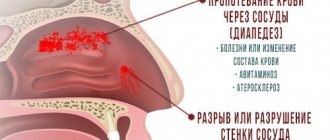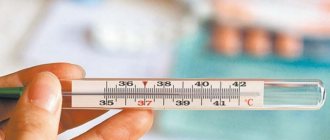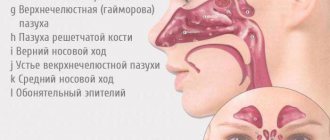The nasal mucosa is rich in blood vessels. Sometimes, for some reason, the integrity of blood vessels can be compromised. This causes nosebleeds.
It is easy to detect the presence of a nosebleed if blood begins to flow through the nostrils. But blood can begin to flow down the back of the throat, often ending up in the stomach, which causes additional symptoms to develop.
Nosebleeds very rarely lead to serious complications, much less death.
Causes of nosebleeds in adults
The causes of nosebleeds are divided into two large groups, namely:
- local factors;
- system factors.
Local are those factors that directly affect the blood vessels in the nasal cavity.
Thus, the most common nosebleeds are caused by trauma to the nose after a blow, surgery or diagnostic procedures, as well as due to the development of acute inflammatory processes in the nasal cavity. In addition, nosebleeds in adults occur due to tumors of the nasal cavity, anatomical deformations, inhalation of drugs and caustic substances. Sometimes dry air, especially during long winter periods, can cause nosebleeds. Systemic factors are those causative factors that do not injure blood vessels, but for the most part affect them from the inside as various diseases. Thus, diseases of the cardiovascular system, allergies, blood diseases, hypovitaminosis and hormonal imbalances, systemic connective tissue diseases and many other diseases can cause the development of nosebleeds.
Why do noses bleed in women?
Epistaxis can be provoked by local or systemic factors. The first are associated with trauma, external influence on the nasal cavity. Local factors are often characterized by bleeding from only one nostril. Systemic causes are considered the most dangerous, because they are associated with the emergence of new diseases of internal organs or exacerbation of old diseases.
System factors
Common causes of nosebleeds in adult women are often associated with increased vascular fragility or various conditions and diseases. These include:
- Unstable blood pressure caused by hypertension, atherosclerosis, lung or liver diseases, adrenal tumors.
- Hemorrhagic diseases - bleeding disorders, leukemia, anemia, aplastic anemia, cirrhosis of the liver.
- Hormonal imbalance – menopause, pregnancy.
- Congenital pathologies – hemophilia, Rendu-Osler disease.
- Taking certain medications - Heparin, Warfarin, Aspirin.
- Lack of calcium in the body, vitamins C or K.
- Infectious diseases - tuberculosis, vasculitis, chickenpox, influenza.
Nosebleeds in healthy women can be provoked by excessive physical exertion, stressful situations, and inhalation of frosty or dry air for a long time. Other local factors include:
- skull injuries;
- atrophic rhinitis;
- deviated nasal septum;
- malignant tumors in the nasal cavity;
- benign neoplasms – polyps, angiofibromas;
- thermal, chemical burns;
- surgery or medical procedures;
- foreign bodies – piercing, hard nasal tamponade.
Nosebleeds during pregnancy
In the first trimester, the cause of frequent epistaxis is a change in the woman’s hormonal levels. An increase in the number of female sex hormones leads to the accumulation of fluid between the cells of the nasal mucosa. A woman experiences a feeling of stuffiness, but there may be no runny nose. Due to the resulting pressure, the vessels become overfilled with blood and become brittle.
In the second and third trimesters of pregnancy, nosebleeds may appear for the following reasons:
- lack of calcium and vitamins;
- prolonged exposure to the sun, indoors with dry air;
- increased blood pressure;
- increased load on the heart;
- infectious diseases;
- decrease in platelet count.
Classification
There are several classifications of nosebleeds. By localization they distinguish:
- 1) Anterior bleeding, which affects the choroid plexus in the anterior part of the nose. In this case, blood flows out of the nostrils quite intensely, but quickly stops if first aid is provided to the person.
- 2) Posterior bleeding, which affects the choroid plexus in the back of the nose. In this case, the blood usually flows down the throat and can enter the stomach. Bleeding of this type rarely stops on its own, since the vessels in the posterior part of the nose are quite large. This condition can be life-threatening, so the person needs medical attention.
- 3) Unilateral bleeding, which is characterized by blood flowing out of one nostril.
- 4) Bilateral, in which blood flows from two nostrils.
There is another classification that divides nosebleeds according to the amount of blood loss. So, they distinguish:
- minor ones, which may result from, for example, blowing your nose;
- moderate, volume up to 200 ml;
- massive, with a volume of more than 200 ml;
- profuse, volume more than 500 ml.
Massive and profuse nosebleeds require the patient to immediately consult a doctor, since there are many reasons for such bleeding and the bleeding may not stop on its own. In addition, voluminous blood loss leads to the development of severe symptoms due to the onset of hemorrhagic shock.
Classification of nosebleeds
The physiological structure of the nasopharynx is individual for everyone and determines two types of epistaxis.
Most often, the so-called “Kiesselbach area” bleeds - a small part in the anterior part of the nasal septum. Anterior bleeding of non-traumatic origin is characterized by a small volume of blood loss that can be quickly stopped. Regardless of the cause of bleeding, blood from one nostril flows out of the nose in adults or children in thin streams or drops.
Why does my nose bleed?
Posterior type bleeding is accompanied by a continuous flow of blood, scarlet in color, which is very difficult to stop on your own. A complication in this case is that blood flows down the back wall of the nasopharynx into the mouth and stomach, which can cause hematemesis.
Sometimes, in particularly severe cases, blood may rise and flow out of the lacrimal punctum or eyes. Fortunately, posterior nosebleeds are observed in only 10-15% of reported cases.
Bleeding from one nostril is classified as unilateral, and from two nostrils it is classified as bilateral.
According to the type of vessel affected: arterial, venous or capillary.
Bleeding from the nose may be the first symptom of dangerous diseases
Based on the volume of leaked blood, 4 degrees of blood loss are determined: insignificant (several milliliters), light (no more than 700 ml), moderate (up to 1400 ml) and severe profuse form, when blood loss is more than 20% of the volume of all blood in the body. A severe form may be accompanied by loss of consciousness, a drop in blood pressure, and general inhibition in the functioning of all systems.
Clinical picture of nosebleeds
The clinical manifestations of nosebleeds are specific.
In a person, depending on the part of the nose in which the blood vessels are affected, blood is observed flowing from the nostrils or flowing down the back wall of the pharynx. In most cases, nosebleeds occur suddenly, only occasionally a person may note the presence of precursors, such as itching and burning in the nose, headache, dizziness.
Minor blood loss does not affect the patient's condition in any way. If blood flows for a long time and its volume does not decrease, symptoms such as weakness, stomach pain, nausea, rapid heartbeat, and pale skin may occur.
Further blood loss can lead to hemorrhagic shock, which manifests itself in a person's confusion, tachycardia and a sharp drop in blood pressure. This condition is dangerous and requires urgent hospitalization of the person.
Diagnostics
Diagnosing nosebleeds in most cases is not difficult.
First of all, the doctor collects an anamnesis of the disease, which allows you to find out important diagnostic information, for example: the frequency of cases, possible injuries, concomitant diseases, the amount of blood lost, the occurrence of symptoms of massive blood loss, etc. A general examination of the patient is carried out in order to identify signs of blood loss, bruises, injuries, obvious pathologies, as well as determination of blood pressure and general condition of a person.
In some cases, nosebleeds are not nosebleeds at all. Blood can flow into the nasal cavity from the larynx, trachea, lungs, and even the middle ear, so determining the source of the bleeding becomes a priority. This requires examinations such as rhinoscopy, endoscopy of the nasal cavity, pharyngoscopy, which make it possible to determine not only the severity of bleeding, but also its source.
In addition, a person must undergo a general blood test to monitor the condition, determine the presence or absence of anemia, and conduct a coagulogram, which allows one to analyze blood clotting.
Treatment and first aid for nosebleeds
A person with a nosebleed may need first aid, the purpose of which is to stop the blood loss.
1) To do this, you need to sit the person down, asking him to tilt his head forward. It is a big misconception that when bleeding you need to tilt your head back. This statement is completely incorrect, since in this case the blood will begin to flow down the throat to the stomach or airways. This is why you need to keep your head tilted forward. It is possible to pinch the nose with your fingers to press down the source of bleeding.
2) You can also apply a cold compress or ice to your nose, especially if your nose is injured. If the bleeding does not stop after performing these steps, it is recommended to place cotton wool soaked in a vasoconstrictor into the nostrils. It is worth noting that under no circumstances should you use vasoconstrictor nasal drops.
3) If the bleeding does not stop after using the methods described above, then you should consult a doctor. Severe cases of nosebleeds are stopped in a hospital setting by thermal or chemical cauterization of the bleeding vessel. Surgery is rarely performed for these purposes.
Subsequent treatment for nosebleeds depends on the causes, frequency of cases and concomitant diseases of the person.
Complications
All complications of nosebleeds come down to the development of conditions that arise against the background of acute blood loss.
Oxygen starvation of the central nervous system and internal organs develops very quickly, the functions of the cardiovascular system are disrupted, and blood pressure decreases.
A person with hemorrhagic shock barely responds to external stimuli, and may experience delirium and confusion. To treat blood loss, a wide range of drugs are used that are designed to normalize the patient’s condition and replenish blood loss.
Nosebleeds are a pathology that often occurs in children and adults due to various causes and diseases. It often begins spontaneously and goes away on its own, but this does not always happen. In some cases, persistent, frequently recurring and massive bleeding indicates serious illness and can lead to the development of anemia and hemorrhagic shock. Therefore, if relapses of nosebleeds are observed, it is necessary to contact a medical institution and undergo the necessary examination.
In our multidisciplinary, experienced ENT doctors will provide emergency assistance in stopping nosebleeds. We also carry out a full range of diagnostic and therapeutic measures to eliminate the causes of nosebleeds.
Causes of nosebleeds
Epistaxis occurs as a result of the physiological characteristics of the blood supply to the nose and can be anterior, from the dense submucosal venous cavernous network of the anterior part of the nasal cartilage (Kiesselbach's zone), or posterior, from larger arterial branches.
Spontaneously occurring bleeding occurs from the Kisselbach area when the nasal mucosa is congested. They are less massive and can pass on their own.
The causes of nosebleeds are divided into local and general.
Local ones include:
- nasal injuries,
- traumatic brain injuries,
- foreign bodies in the nose,
- various tumors, especially vascular ones, polyps,
- thinning or congestion of the mucous membrane in acute and chronic runny nose, infections,
- deviated nasal septum,
- surgical interventions.
Common causes of nosebleeds include:
- arterial hypertension (high blood pressure),
- blood diseases (leukemia, etc.),
- hemorrhagic diathesis,
- bleeding disorders,
- avitaminosis,
- heart defects and other cardiovascular pathologies,
- kidney diseases,
- severe infectious diseases and immunodeficiencies,
- congenital vascular pathology,
- hypothermia or overheating in the sun,
- physical stress.
Our clinic’s specialists will help identify the causes of nosebleeds in the shortest possible time using modern diagnostic technologies.
Common reasons
Most often, nosebleeds occur due to high blood pressure in people with heart defects, hypertension, atherosclerosis, kidney disease, and diabetes. Such people have warning signs of bleeding: tinnitus, headache, dizziness.
With colds, ARVI, flu, which are accompanied by rhinitis, sinusitis, the capillaries of the nose become overfilled with blood and may not withstand such pressure. In addition, they are also damaged by toxins produced by viruses.
Patients suffering from hemorrhagic diathesis and poor blood clotting are also susceptible to nosebleeds. They can appear during acute infectious diseases, when a very high temperature lasts for a long time.
Bleeding from the nose is a common occurrence for many pilots, divers, and climbers. In them, this pathological syndrome occurs due to sudden changes in barometric pressure, which is many times higher than normal pressure.
Increased bleeding of nasal capillaries can also be a symptom of diseases of the spleen or liver. Fragility and high permeability are characteristic of the walls of blood vessels even with vitamin deficiencies.
It is important to distinguish “anterior” nosebleeds from “posterior” ones. In the anterior section of the nasal apparatus there is the Kisselbach zone, abundantly intertwined with a network of capillaries. She is the “supplier” of blood in 90-95% of cases. “Anterior” bleeding is short-term, anemic, and easy to stop.
The “back” is extremely dangerous. It occurs when large vessels in the deep parts of the nasal apparatus are damaged. Blood loss can be significant, and in everyday life, people far from medicine are usually unable to stop its flow.
Nosebleeds, which has the scientific name epistaxis, is a fairly common pathology that every adult has encountered at least once in their life. It is characterized by bleeding from the nose, which occurs due to rupture of blood vessels. It happens that the blood loss is so great that it poses a threat not only to the health, but also to the life of the patient. The nasal mucosa is very thin and is characterized by the presence of a very large number of blood vessels. As a rule, when they are damaged, blood flows out of the nostrils (or one nostril), but it happens that the contents of the vessels enter the larynx.
Experts include local factors :
- external or internal trauma to the nose;
- the presence of a foreign object in the nasal cavity;
- inflammatory diseases, such as ARVI, sinusitis, rhinitis, sinusitis;
- abnormal development of the vascular system of the nasal cavity;
- drug use by inhalation;
- cancer of the nose;
- low humidity of the air that the patient inhales for a long time;
- the use of a nasal oxygen catheter, which dries out the mucous membrane;
- frequent use of certain medications in the form of a nasal spray;
- surgical interventions.
System factors include:
- allergic reactions;
- hypertension;
- increased physical activity;
- sun or heatstroke;
- colds;
- side effects of certain medications;
- frequent consumption of alcohol and alcohol-containing drinks, which cause dilation of the vessels of the nasal cavity;
- diseases of the circulatory system;
- liver pathologists;
- heart failure;
- severe infectious pathologies in which there is an increase in vascular permeability;
- some hereditary diseases;
- professional activities that are associated with sudden surges in pressure (divers, climbers, submariners);
- hormonal imbalances, for example, during pregnancy.
Video about the causes of nosebleeds
Causes in older people
This is due to age-related changes in the nasal mucosa - it becomes much drier and thinner. At the same time, the function of vascular contraction is much lower than at a younger age. In more than 80% of cases when older people consult a specialist, the patient is diagnosed with disorders in the hemostatic system.
In addition, in elderly patients there is a sharp progression of hypertension, in which the fragile nasal vessels are unable to withstand blood pressure and rupture. In cases where elderly people, along with signs of hypertension, experience nosebleeds, it is very important to seek urgent help from medical professionals, because such a situation indicates that hypertension has reached its peak.
Reasons why bleeding is observed from only one nostril
The following reasons contribute to the occurrence of blood flow from one nostril:
- deviated nasal septum;
- trauma to a vessel of the nasal passage;
- presence of a foreign object in the nasal passage;
- the presence of a benign or malignant neoplasm in the nostril.
Symptoms
The main symptom of the pathology is blood from the nose, from both or one nostril, as well as blood flowing down the back wall of the nasopharynx. Bleeding may be small in volume. Typically, such bleeding resolves spontaneously. Heavy nosebleeds require medical attention, as they lead to large blood loss and do not go away on their own. Massive bleeding can be accompanied by palpitations, general weakness, headache, dizziness, shortness of breath, up to the development of shock and death.
If blood appears from the nose, in any case it is necessary to contact an otolaryngologist who will conduct an examination and prescribe additional examination on an individual basis. Our clinic employs experienced and qualified doctors who can help you cope with any type of nosebleed.
Recurrent bleeding can lead to anemia, which may also require medication. Therefore, our experts recommend not delaying a visit to the doctor and treating the disease at the first symptoms.
Diagnosis and treatment of nosebleeds
Diagnosis of local causes of nosebleeds is not difficult. An ENT doctor can identify the cause of bleeding by examining the nasal cavity and examining the nasopharynx using special instruments. Diagnosis of common causes of pathology may require laboratory tests and consultations with doctors of other specialties: cardiologists, hematologists, etc.
To eliminate nosebleeds before being examined by a doctor, it is recommended to: take a position with the head end elevated, apply cold to the bridge of the nose, and press the wings of the nose to the septum. If these techniques do not work, you can install a small tampon of sterile cotton wool soaked in 3% hydrogen peroxide or a vasoconstrictor (tizin, galazolin, sanorin, naphthyzin, 0.1% adrenaline).
If the bleeding does not stop, you should consult a doctor immediately. In such cases, the doctor uses anterior or posterior nasal tamponade with hemostatic (hemostatic) sponges or powders, cauterization of the bleeding vessel with a laser, liquid nitrogen or electricity. In case of persistent life-threatening bleeding, they may resort to detachment of the periosteum in the area of bleeding, which leads to emptying of the vessels, as well as ligation of large arteries.
Even if the nosebleed has stopped, acute blood loss may require treatment. In this case, blood transfusions and the administration of medications that reduce oxygen deprivation and increase the volume of circulating blood are necessary.
The specialists of our clinic know all the methods of conservative and surgical stopping nosebleeds and preventing their recurrence. If you experience nosebleeds, do not hesitate to contact our otorhinolaryngologists.
Nosebleeds and epitaxis are a fairly common pathology. When a nose bleeds, blood vessels rupture. Sometimes epitaxy leads to large losses.
That is, a person can lose up to 20 percent of his blood, which becomes very dangerous for a person. In this case, emergency assistance should be provided. Help from a doctor is the only right decision. Moreover, the causes of nosebleeds in adults can be very different.
When the blood vessels are damaged, the resulting fluid flows out of the nostrils. If the case is very serious, bleeding from the larynx may occur. Usually the vessels are damaged accidentally, that is, when the nose itself is injured. At the same time, a larger percentage of injuries occur in childhood. Bleeding in adults applies more to people over 50. Moreover, the pathology of the situation is more typical for men.
What are the causes in adults over 50 years of age? Here, the main role is played by the vessels, which, the older the person, the weaker the vessels. In addition, people over 50 are more likely to have arterial hypertension. In 80% of cases, the causes in adults arise from the condition of the hemostatic system, which wears out with age.
Today, there are two types:
- Anterior, when blood flows out;
- The rear is more dangerous. After all, in this case it is impossible to do without medical assistance. Here the blood does not flow out of the nostrils. It flows through the nasopharynx and enters the body.
Preventing nosebleeds
Prevention of nosebleeds in adults includes:
- maintaining cleanliness, temperature and humidity in the room;
- proper hygiene of the nasal cavity - nails should be cut short, cotton swabs and other objects that can injure the mucous membranes should not be inserted into the nasal cavity;
- blood pressure control in hypertensive patients and persons susceptible to this disease;
- prevention of facial and head injuries;
- timely diagnosis and treatment of inflammatory diseases of the nose and nasopharynx.
In addition, it is important to eat a balanced and nutritious diet, especially when the body’s need for vitamins is increased - during puberty, during pregnancy, after infectious diseases, operations.
Persons with existing hereditary diseases of the blood and blood vessels should periodically undergo detailed tests and visit a hematologist.
It is also not recommended to use nasal drops with a vasoconstrictor effect for more than 3 days, since they quickly become addictive to the body and contribute to the development of atrophic changes in the mucous membranes. The same applies to hormonal sprays - it is better not to use them yourself without a doctor’s prescription.
Causes of nosebleeds in adults and what to do about it?
Let's figure out what are the causes of nosebleeds in adults. Pathology develops if:
To begin with, when this situation arises, it needs to be stopped. Then diagnose the presence of a particular disease.
To stop the problem you need to:
- Place the person in a position so that blood from the nose can flow out unhindered;
- Cold, that is, ice, should be placed on the bridge of the nose or on the neck and forehead. At the same time, you need to make sure that your feet are warm at this moment;
- Press one wing of the nostril against the septum for 10 seconds. 10 minutes is enough for her to stop. If this does not happen and the blood continues to flow just as heavily, then you need to rinse your nose with salt water, and then insert tampons slightly moistened with hydrogen peroxide into your nose. Sometimes, in order to stop nosebleeds in an adult, hemostatic drops may be needed. You can buy them at any pharmacy. After it has been stopped, it is necessary to reconsider what could have caused this condition. Until the cause is established, you need to spend more time in the fresh air, start hardening and include foods rich in vitamins and microelements in your diet.
You can find out more about the reasons here:
Why does my nose bleed?
The causes of nosebleeds can be local or general.
Causes of nosebleeds in adults
The most common causes of nosebleeds in adults include:
- various nasal injuries;
- foreign bodies entering the nose, as well as injury to the internal nasal cavity with a finger;
- inflammatory diseases (ARVI, allergic rhinitis, chronic sinusitis, etc.).
Other possible causes of local nosebleeds in adults include:
- a sharp change in barometric pressure, which results in barotrauma, which occurs most often in climbers, pilots, and divers;
- prolonged inhalation of frosty air with low relative humidity;
- inhaling cocaine or certain other drugs through the nose;
- sun or heatstroke;
- anatomical deformities of the nose (telangiectasia or deviated nasal septum);
- surgery in the nose;
- benign and malignant tumors of the nose;
- drying of the nasal mucosa as a result of the use of an oxygen catheter.
The most common systemic causes of nosebleeds in adults include:
- arterial hypertension;
- allergies;
- colds.
Other possible causes of nosebleeds in adults include:
- heart failure;
- blood diseases (ITP, hemoblastosis, anemia, etc.);
- vascular diseases;
- alcohol consumption;
- deficiency of vitamin K or C in the body;
- side effects from the use of medications;
- systemic connective tissue diseases.
Causes of nosebleeds in adults and how to stop it
In 80 percent of cases, nosebleeds in adults begin as a result of damage to blood vessels. The most common cause of nosebleeds in adults is associated with sudden changes in blood pressure. In addition, it can open in cases of overwork, when a person systematically lacks sleep, has suffered stress, or has an acute respiratory viral infection. This may also indicate a lack of vitamin C in the body or the person has suffered a heat stroke. And in some cases it occurs due to poor clotting, which can only be determined by laboratory testing.
As a rule, this situation is accompanied by headache, tinnitus and unpleasant sensations in the nose.
The main thing is to provide assistance in a timely manner. To do this, you need to immediately determine which nostril the blood is coming from. Then you need to roll up a small tampon, soak it in hydrogen peroxide or a weak saline solution and insert it into the nostril. The tampon is inserted so that it becomes a barrier and at the same time does not cause pain in the nose area.
You also need to sit the person so that his head is slightly lowered down, and something cold needs to be applied to the back of his head. You can pinch your nose for 10-15 seconds. Usually this time is enough for it to stop flowing. If the bleeding is severe, fibrinolysis or tranexam is used to stop it.
Whatever you do, the main thing is that the person does not assume a horizontal position. Moreover, he didn’t lift his legs. Thus, the flow increases and the nosebleeds become worse, which is much more difficult to stop. At the same time, do not blow your nose, do not apply warm water to the bridge of your nose and the back of your head, do not drink coffee, especially alcoholic beverages. If you experience repeated nosebleeds, consult a doctor to determine the cause of the nosebleed.
Why does my nose bleed?
The causes of nosebleeds can be local or general.
Causes of nosebleeds in adults
The most common causes of nosebleeds in adults include:
various nasal injuries; foreign bodies entering the nose, as well as injury to the internal nasal cavity with a finger; inflammatory diseases (ARVI, allergic rhinitis, chronic sinusitis, etc.).
Other possible causes of local nosebleeds in adults include:
a sharp change in barometric pressure, which results in barotrauma, which occurs most often in climbers, pilots, and divers; prolonged inhalation of frosty air with low relative humidity; inhaling cocaine or certain other drugs through the nose; sun or heatstroke; anatomical deformities of the nose (telangiectasia or deviated nasal septum); surgery in the nose; benign and malignant tumors of the nose; drying of the nasal mucosa as a result of the use of an oxygen catheter.
The most common systemic causes of nosebleeds in adults include:
arterial hypertension; allergies; colds.
Other possible causes of nosebleeds in adults include:
heart failure; blood diseases (ITP, hemoblastosis, anemia, etc.); vascular diseases; alcohol consumption; deficiency of vitamin K or C in the body; side effects from the use of medications; systemic connective tissue diseases.
Causes of nosebleeds in children
Nosebleeds in children most often occur from the anterior parts of the nasal septum. The immediate cause of this phenomenon is considered to be a violation of the integrity of blood vessels.
Common causes of nosebleeds in children include:
vitamin deficiencies, including vitamin C deficiency; increased blood pressure; hypertension in adolescents during puberty; pathology of the blood coagulation system; congenital heart defects; chronic liver and kidney diseases; overheating, including hyperthermia in infectious diseases.
Local causes of nosebleeds in children include:
any trauma to the nose (including nose picking), entry of a foreign body into the nasal cavity; deviated nasal septum; chronic and anterior dry rhinitis; benign and malignant neoplasms of the paranasal sinuses and nasal cavity.
Causes of nosebleeds in adults from one nostril
This may be triggered by special sexual development. Hormonal changes, trauma to the nose, all this can cause bleeding from one nostril. This is not a rare occurrence and causes a lot of trouble, although they are not signs of a serious illness.
Folk remedies can help cope with such symptoms.
A good folk remedy is lemon, caraway seeds, and aloe. Methods and recipes for preparing a hemostatic agent can be found on the Internet.
But, if bleeding occurs very often and does not stop for a long time, then the only correct solution is to consult an ENT doctor. He will determine the cause and prescribe appropriate treatment.
Injuries to the internal structures of the nose, including the mucous membrane, lead to damage to the blood vessels. This often happens when foreign bodies enter. And even because of the banal “picking your nose” with your finger, what makes children especially different.
A long stay under the scorching sun or visiting a steam room may also well lead to this outcome. With strong physical stress, the load on the capillaries of the nasal apparatus also increases significantly. Blood can come from the nose even from a sharp drop in atmospheric pressure. And, as a rule, from one nostril. It starts suddenly and stops quickly, without threatening your health.
Nosebleeds occur due to various inflammations of the nasal cavity. Such consequences are caused by a strongly curved nasal septum and mucosal degeneration.
Today, neoplasms are increasingly being detected in the nasal apparatus. These are various angiomas, polyps, granulomas, papillomas. Rarely, malignant tumors (sarcomas) also occur. The result of the destructive action of such pathological processes is fragility and bleeding of blood vessels.











